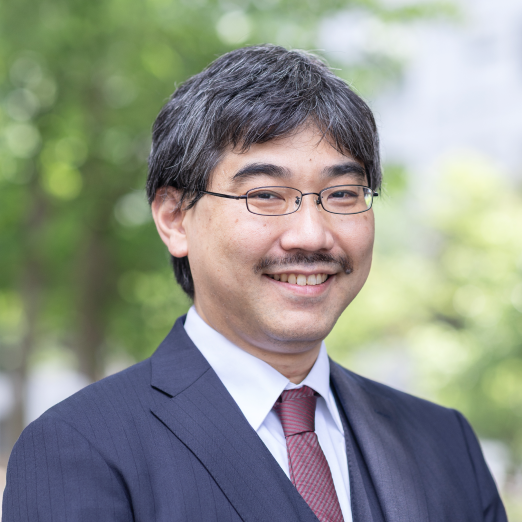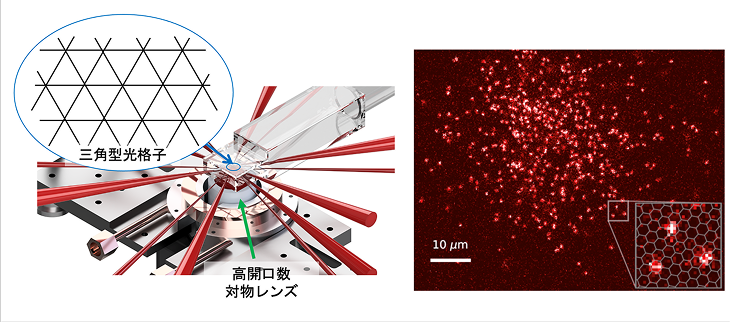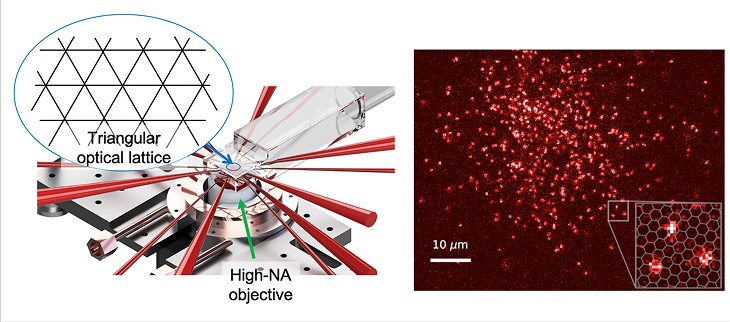
福原 武 教授(任期付)
Takeshi Fukuhara
専門分野
量子多体制御
量子多体系を単一原子レベルで制御する
研究テーマ
冷却原子を用いた量子多体系研究
キーワード
冷却原子, 量子気体, 光格子, 量子シミュレーション
LINKS
RESEARCH OVERVIEW
研究概要
原子などの一つの小さい粒子がどのように振舞うかは量子力学を考えれば(その振る舞いが非日常的であることを除いて)容易に理解することができます。では、粒子がたくさん集まった「多体系」ではどうでしょう。粒子間の相互作用や粒子の量子統計的性質によって多様な現象が発現する一方で、一般に問題を解くことは困難になります。この量子多体系の問題を理解することは、素粒子物理から物性物理、そして宇宙物理にいたるまで幅広い物理系における現象を理解するうえで重要な課題となり、様々な研究が取り組まれてきています。その意味では量子多体系を理解することは物理の宿命的課題といえるでしょう。この研究室では、主に実験系を通してこの量子多体系の謎に挑みます。
適切に調整したレーザー光を原子に照射すると、原子気体をマイクロケルビン台まで冷却することが出来ます。これが冷却原子と呼ばれるもので、我々のメインのツールになります。この冷却原子は蒸発冷却という手法を用いることで更に冷やすことができ(ナノケルビン台まで!)、量子統計性が顕著になる量子気体になります。例えば、ボース統計性に従う原子集団の場合、ボース・アインシュタイン凝縮を起こし、全ての原子があたかも一つの波のように振舞い、超流動性を示します。この冷却原子・量子気体のシステムは、とてもシンプルな物理モデルで記述され、システムのパラメータの制御性に優れているため、非常によい量子多体系研究の舞台となります。
では、実際に研究室で行う実験をイメージしてみてください。量子気体を光で形成した周期的な構造(光格子)に入れると、固体物質(結晶格子中の電子)と似たシステムを作り出すことができます。この対応を用い、固体物質のシミュレーション(量子シミュレーション)を行います。システムのパラメータを変えていったときにどのような量子相が実現するのか、どのような量子現象が発現するか、これらの問いに冷却原子実験から挑んでいきます。
優れた制御性の最たる例としては、量子気体を単一原子レベルで測定したり、操作したりする「量子気体顕微鏡」という技術があります。この技術を用いることで、これまで見ることが難しかった物性物理のミクロな情報や量子相関などにアクセスすることができるのです。また、測定に基づいて単一原子レベルでの操作を施すことにより、「マクスウェルの悪魔」を量子多体系において実現することも出来るのではないかと考えています。量子多体系における量子統計性や相互作用の効果を、実験を通して検証していくことができるのです。
更に近年では、レーザー光で補足した個々の原子を量子ビットとして用い、量子コンピュータを開発するという流れも注目を集めています。量子多体系に対する究極的な制御を実現し、量子多体系の理解を深めるとともに、その応用へと結びつけていくことが私たちの目標です。

三角光格子中の極低温原子気体に対する単一原子観測(右図)。
MESSAGE to STUDENTS
学生へのメッセージ
量子多体系の研究や量子技術に興味を持つ皆さんとともに、量子の謎に挑み、量子を活用した究極的な技術を開発することで、人類の理解と到達範囲を広げていきたいと考えています。
一緒に、量子の奥深い魅力を探求する過程を楽しみましょう。
学歴・経歴
2009年 京都大学大学院理学研究科 博士課程修了、博士(理学)
2009年 科学技術振興機構 ERATO上田マクロ量子制御プロジェクト 研究員
2010年 ドイツ マックスプランク量子光学研究所 博士研究員
2014年 理化学研究所 創発物性科学研究センター 統合物性科学研究プログラム ユニットリーダー
2021年 理化学研究所 量子コンピュータ研究センター ユニットリーダー
2022年 理化学研究所 量子コンピュータ研究センター チームリーダー
2024年 早稲田大学理工学術院 教授(任期付)(現職)
2025年 理化学研究所 量子コンピュータ研究センター チームディレクター(現職)
所属学協会
- 物理学会
- 応用物理学会
- ドイツ物理学会

Takeshi Fukuhara
Professor (non-tenure-track)
Field of study
Quantum Many-Body Control
Controlling quantum many-body systems at the single-atom level
Research Themes
Experimental study on quantum many-body system with cold atoms
Keywords
Cold atom, Quantum gas, Optical lattice, Quantum simulation
RESEARCH OVERVIEW
The behavior of a small particle such as an atom can be understood easily using quantum mechanics. However, in many-body systems where many particles are gathered, it is generally difficult to solve problems due to effects of interactions between particles and quantum statistics of particles (though these effects give rise to a variety of phenomena). Understanding quantum many-body systems is a central challenge in elucidating phenomena in a wide range of physical systems from elementary particle physics to condensed matter physics and astrophysics. Various studies have been undertaken for this challenge. In this laboratory, we are tackling problems in quantum many-body systems mainly through experimental studies.
By irradiating atoms with a precisely tuned laser beam, one can cool atomic gases down to below 1 mK. This object is called cold atoms, which is our experimental platform. These cold atoms can be further cooled to below microkelvin by using evaporative cooling, and then they become a quantum gas with pronounced quantum statistical properties. In the case of bosonic atoms, Bose-Einstein condensation occurs, and all the atoms behave as if they were a wave. Because this system can be described by a simple model and its parameters are highly controllable, it has been attracting attention as a new platform for studying quantum many-body systems.
By loading a quantum gas into a periodic structure (optical lattice) formed by laser beams, one can prepare a system similar to a solid material (electrons in a crystal lattice). Using this correspondence, we can simulate solid-state systems, which is called quantum simulation. Our experiments can address questions like: What kinds of quantum phases can be realized? and What novel quantum phenomena emerge in these systems?
A prime example of excellent controllability is the technology known as a quantum gas microscope, which enables us to measure and manipulate quantum gases at the single-atom level. Using this, we can directly access microscopic information and quantum correlations that were difficult to observe in condensed matter systems. We also consider that, by manipulating individual atoms based on measurements, one can realize the “Maxwell’s demon” in quantum many-body systems, where we can study effects of quantum statistics and interactions.
Furthermore, in recent years, atoms captured by laser light are considered as a promising candidate for qubits of quantum computer. Our goal is to achieve ultimate control over quantum many-body systems, deepen our understanding of quantum many-body systems, and utilize the control for quantum applications.

Single atom detection of ultracold gases in triangular optical lattices (right).
MESSAGE to STUDENTS
I hope to work together with those of you who are interested in quantum many-body systems and quantum technologies to tackle the mysteries of quantum mechanics and develop groundbreaking technologies that harness its potential. Though this, we can expand the boundaries of our understanding and capabilities.
Let’s enjoy the journey of exploring the profound world of quantum together!
Education and Career
2009 D. Sci., Kyoto University
2009 Researcher, ERATO Ueda Macroscopic Quantum Control Project, Japan Science and Technology Agency
2010 Postdoctoral researcher, Max Planck Institute of Quantum Optics, Germany
2014 Unit Leader, Cross-Divisional Materials Research Program, RIKEN Center for Emergent Matter Science
2021 Unit Leader, RIKEN Center for Quantum Computing (RQC)
2024 Team Leader, RIKEN Center for Quantum Computing (RQC)
2024 Professor (non-tenure-track), Waseda university (-present)
2025 Team Director, RIKEN Center for Quantum Computing (RQC) (-present)
Professional Memberships
- Physical Society of Japan
- Japan Society of Applied Physics
- German Physical Society
